Abstract
This study is based on selected poems in
Keywords: Sudoku poetrymathematical conceptsformalistictypography poetry
Introduction
Malaysian modern poem rapidly grows since early 1960s until today. Creation of modern poems encompasses various enhancement which covers the aspect of structure and language style that are able to draw the public to appreciate them. Hence, poets create modern poems as an effort to revive and recreate the poems in different forms to produce new and interesting poems which can attract more readers. Concrete and experimental poems have longed been introduced, but they were not given much attention by Malaysian poets, let alone to produce them. According to Abdullah and Yusof ( 1990), there are several poets who are very passionate about typography poems namely the ones introduced by Suhaimi Haji Muhammad in his compilation of poems entitled Bumi Hijau which was published in 1971 in the category of concrete poems. These types of poems were later expanded by poets such as A. Samad Said, A. Latiff Mohidin, Ahmad Kamal Abdullah, Abdul Ghafar Ibrahim, Ismail Abdullah and Puzi Hadi. Their poems have interesting typography form and visually appealing as they carry humanistic philosophy for the public to comprehend. The production of experimental poem in the form of Sudoku have not been produced in Malaysia. Poems with Sudoku as well as mathematical concepts were written by Puzi Hadi in his work
Most poets crave a wider readership. In pursuit of this, they give public readings, publish volumes and submit poetry to literary journals. This is an endeavour with limited payback, as the readership tends to be poets reading and listening to other poets. For mathematical poets especially, it can be an even greater challenge to expand a readership that is arguably more fracture. (p. 645)
Based on this study, she has concluded that most poets need a vast number of readers. Therefore, the writers must strive to produce poems which attract readers’ interest who are not from the literary field to appreciate them. Creating poems in the form of cross puzzle will add to bigger pool of readers to find interest in literature. One example of “Poetry Puzzle” is listed below as Figure
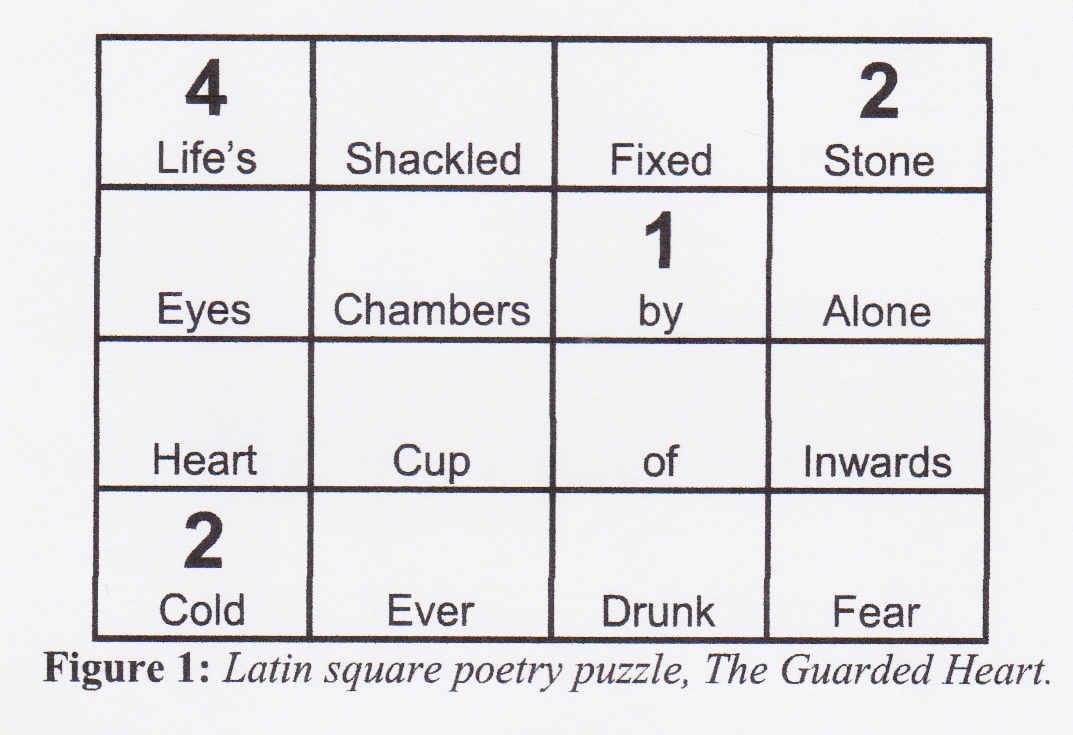
The poems studied are in the form of Sudoku which has puzzles to solve using the game’s concept. Empty spaces must be filled by the researchers with suitable numbers based on Sudoku games: this process leads to the creation of an interesting poem. To conclude, writing a poem in the form of Sudoku provokes the readers’ minds to think and analyze the meaning the poet wishes to convey. Mathematical concept is brought to life in the writing on a poem in Sudoku form.
Problem Statement
Typography's poetry is well known abroad. However, in Malaysia, there is still a lack of response from poets and audiences who are interested in the field of poetry. There are some previous studies conducted by scholars on typographic poetry but studies on sudoku-type typography have shown that mathematical concepts are rarely introduced in this country.
Moreover, the audience is still less interested in and does not understand sudoku-type typography. Therefore, this study will analyze the Sudoku-shaped poems selected in the Sudoku Poetry collection by Puzi Hadi. Based on the researcher's observations, the typographical poems produced are quite complex including alphabets, characters, vocabulary, numbers, images and symbols that certainly have a somewhat critical meaning for the reader to understand. Thus, the researcher sought to analyze the thoughts embedded in the typographical poems produced by Puzi Hadi.
Research Questions
Several research questions have been developed to achieve the objectives of the research. Among the research questions that need to be solved are what is the form of sudoku poetry in typography poetry by Puzi Hadi? Next, do the forms of Puzi Hadi's sudoku poetry resemble the concept of sudoku in mathematical games? What is the meaning of my poodle poems produced by Puzi Hadi? What message or thought does the poet want to convey? These questions need to be answered to meet the objectives of the study.
Purpose of the Study
It is hoped that the findings of this study will enhance the knowledge of scholars in the field of modern poetry. In addition, this study will be able to add new ideas to young writers to produce Sudoku-type typographic poems that have a high value of thought and philosophy in the production of modern poetry. Next, the audience will be able to know in more detail the meaning of Sudoku-type typography poems that are difficult to understand. Finally, through this study, the audience will be able to absorb the ideology that the poet wants to convey. Exposure to this mathematical concept will increase the interest of non-literary audiences to enjoy sudoku poetry.
Research Methods
The research methods that will be used are library studies, text analysis studies, and web search methods to find important information for completing this study. The theory and approach used are based on formalistic theory.
Library Studies
Library studies are conducted in several libraries and documentation centers in Malaysia which include some of the following: Hamzah Sendut Library, University of Science Malaysia Resource Room of the School of Human Sciences, University of Science Malaysia Tuanku Bainun Library, Sultan Idris University of Education Sultanah Bahiyah Library, Public Library, Jitra Kedah and Public Library Corporation, Alor Setar. The keywords are used to search information in the databases is “typoghraphy”, “Patterns of Poetry”, “Modern Poetry”, “Sudoku”, “MH 370”, “Visual poetry”, “Puzi Hadi”, “Formalistic Theory” and “Mathematical concept”.
Text Analysis Studies
The text analysis method is the main method of this study which is to be analyzed using selected poems in
Web Search Method
This method is used for additional information besides reference books in the library. This search is for information on typographic studies that have been stored in blogs or online journals. The selected websites are using Google search, Google Scholar, Google Books, Amazon.com and Academia.edu. This method is also used to find information on past studies and to assist in the research process.
Formalistic Theory and Approach
This study applies a formalistic approach used to study the form and content of poetry. It is also a New Critical-based formalistic approach to modern criticism. Sikana ( 2013) concludes that “formalistic theory is derived from Aristotle's emerging poets in America under the name of new critics and in Russia with formalism, and in France analytically and in Malaysia as formalists” (p. 44). The formalistic approach is based on form and content in evaluating a literary work. According to Aziz ( 2003), “the New Criticism is a literary criticism that rejects the form of literary criticism in the 19th century that was supported by the Romanticists” (p. 3). This objection is due to the New Critical approach of treating literary works as objects separate from its author and its historical context. T. S Eliot is a leading figure in the development of formalistic theory. According to Scott ( 1966) in his paper entitled "The Formalistic Approach" is as follows:
T.S. Eliot is a major figure in the development of formalistic criticism. Under the influence of Pound and Hulme, he announced the high place of art is art, rather than as an expression of social, religious, ethical, or political ideas, and advocated the close study of the texts of the work themselves. (p. 179)
In this regard, T.S. Eliot has argued that art is art and not influenced by external ideas such as social, religious, political influence and so on. Thus, the formalistic stream focuses on literary works based on intrinsic aspects that aim to produce the achievement of goals in the study of works. Extrinsic opinions such as the influence of the poet's personality, the background of the poet and the function of the literary work are ignored. The quality of the work will be seen based on the study of the work of the literary works of various components and of their own shape. The research is done on the components that are processed and constructed and built into the literature. Quality work is the production of harmony and balance of form that is mixed with content in literary works. A second great guide is I. A. Richard. According to Aziz ( 2003), “Richards rejected the author's relationship with his work” (p. 3). He paid attention to the critical question of what value was given to the experience of reading the poem? Next, how would you rate an experience reading a poem? Richards focuses on analyzing the reading process and finding criteria that can be used to evaluate the experiences they produce. Eliot and Richards' views are in agreement with New Criticism and have elevated literary works as stand-alone art.
According to Sikana ( 2013), the formalistic approach is used in analyzing literary texts based on the foundations of literary texts (p. 38). It explores in detail the structure of the work, examines the themes and thoughts, seeks out the message and message that the author wishes to convey. Based on this fact, a formalistic approach is an evaluation of a literary work based on the components that make up the literary work. Elements and aspects that develop the work are considered to evaluate the quality of the work produced by the author. Assessments are more intrinsic and leave out extrinsic aspects. The background and the author of the work is not a priority because the focus of the study is on the work alone. Sikana ( 2013) lists the principles of formalistic approach as follows:
The study of poems based on formalistic approaches is more focused on language construction and style. The strength of the poem is emphasized in the successful aspect of the expression of the verse. Its components emphasize aspects of the poem such as alliteration, assonance, personification, simile, metaphor and so on.
Formalistic emphasizes on the success of a work in terms of content and form as a guide. Conformity, balance and cooperation between content and form are the key criteria for ensuring a success of a work.
Content and form need to be treated with good technique.
A formalistic approach to looking at a literary work based on the components that make up the work, it is hoped to be able to examine the work objectively and fairly.
Factors of fairness and honesty of the researcher in evaluating the work formalistic critics try to see the unity and harmony between content and form. Examples of matters related to questions, thoughts, philosophy and so on (pp. 38-39).
This study will select appropriate principles such as emphasizing the basics of textual poetry construction. The poetic form refers to the external or physical poetry that includes the subject, line, syllable and design of the whole work. According to Salleh ( 1988), “the form can be considered the skin of a poem that is visible to the reader. But the form of a work is much broader in meaning than its visible properties” (p. 13). Even the actual form, the design of the whole work, including the way in which each part is organized, its external appearance and content; a short synopsis of the nature, rules, sounds and sounds that make it and how it is written. In this regard, this study is based on forms of poetry based on sudoku form or vice versa. The textual analysis of this poem will study in detail the structure of the poem as well as explore the themes and thoughts, find the message and message that the poet wants to convey.
Findings
The study focused on selected poems from the
Mathematical Concepts in Sudoku
Mathematics is a branch of science that teaches people to think logically to solve problems that arise in various daily affairs of life. Sang ( 1996) states that “mathematics can be thought of as a way of thinking, a study of patterns, a study of relationships, an art and a language of its own, a tool in social life and human recreation” (p. 6). Thus, knowledge in mathematics is very important in managing daily needs and making life more systematic and meaningful. Mathematical concepts can be introduced through formal or informal learning processes. Sudoku is a math game that originates from Japan and is conceptualized in solving problems based on the rules of the game. Sudoku means 'private number'. While in the United States, this game is known as Number place. The mathematics of sudoku is a recent field of interest and for research. According to Jussien ( 2007) the meaning of sudoku is as follows:
The word Sudoku is the abbreviation of Japanese expression: suji wa dokunshin ni kagiru (every digit must be unique). Actually, it is the name of the game when it was first published in the Japanese magazine Nikoli in 1984. Su means digit and doku means single (p. 11).
As such, Sudoku games involve personal numbers and generate high level thinking ability in solving the game. Each level of game difficulty is determined by the player's ability. The Sudoku game method involves 81 cells arranged in a 9x9 grid split into 9 3x3 grids. Some of the grid will be empty. Players will fill in the remaining numbers on each row and column and each 3x3 box contains numbers 1 through 9. Through this activity will stimulate students' interest in mathematics. Examples of Sudoku games as shown in Figure
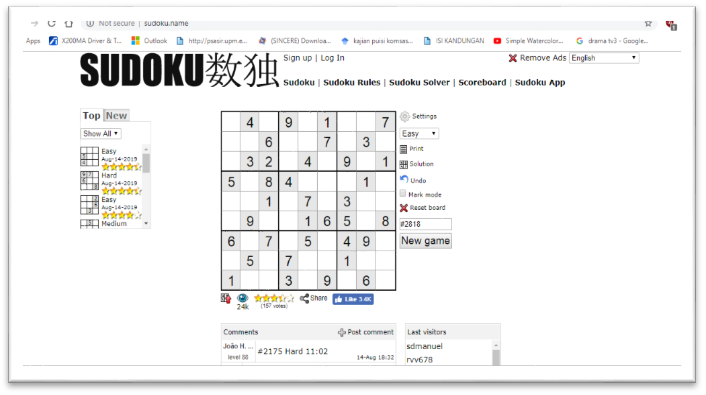
This Sudoku game as shown in Figure
An Analysis of The Poem “Mohamad Morsi-Dalam Catur Dalam Penjara”
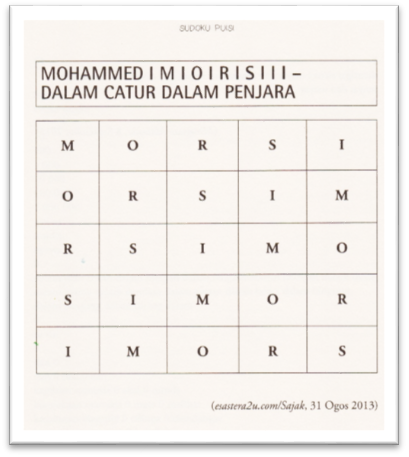
Form
The poem ‘Mohamad Morsi-Dalam Catur Dalam Penjara’ in Figure
Themes and Questions in Poetry
Based on the form of the Sudoku poem, the poet has chosen the title ‘Mohamad Morsi-Dalam Catur Dalam Penjara’. This title allows the audience to appreciate and explore the themes and questions that the poet wants to convey. Who is Mohamad Morsi? An inexperienced reader must be wondering. Thus, further reading with the search for information through current media especially the internet will surely provide more acurate knowledge to the readers. This concept is in line with the mathematical concept, which is based on logical reasoning to enable the audience to solve the problem. The appearance of a rectangular shape in prison signifies that Mohamad Morsi is in custody,behind bars. The poem is a theme of the political crisis that occurred in Egypt during the US intervention on the Egyptian political system under the leadership of Egyptian President Mohamed Morsi. According to Akbar ( 2015), “the election of Mohamad Mursi in Egypt in 2012, strongly supported by Ikhwanul Muslimin, was a major blow to the United States and it sought to intervene in Egypt” (p.59). This was because the Americans want to keep their interests in the country. In addition, some unrest caused the Egyptian military to overthrow the Ikhwanul Muslimin leadership and imprisoned Mohamed Morsi. According to Dr. Maszlee Malik as cited in Osman ( 2013), the crisis in Egypt is a violation of the democratic system, a denial of the rights and aspirations of the people in the presidential election. Thus, the turmoil has led the elected leaders of the people to prison. Mohamed Morsi finally passed away on June 17, 2019 at the time of his trial in court. His passing left a deep impression on Muslims around the world. It turns out that the themes and issues raised by written texts cover the latest issues that need to be addressed to the public.
The Poet’s Thought
According to the analysis, the poet chose Mohamed Morsi issue because he was concerned about the religious community in troubled Egypt. The poet was impressed by the overthrow of a democratic government led by Mohamed Morsi by an Egyptian army that was a fragment of Hosni Mubarak's followers. This depravity is very sad for the whole world. The issue is highly relevant and to this day the sad history of the death of Mohamed Morsi on June 17, 2019 remain in the hearts of money. This exposure should be made available to the public to pay attention to issues of turmoil that threaten world peace and stability. The voice of grief is expressed creatively by the poet by producing Sudoku-shaped poems that are different from other forms of modern poetry writing. The alphabetical combination of Sudoku poems reflects the mathematical elements integrated into the production of this poem. It turns out that the poet's thinking is more inspired to inspire the audience to embrace Sudoku-shaped poetry and stimulate the mind to appreciate and explore the latest issues presented by the poet.
An Analysis of The Poem ‘Sudoku Puisi: Misterius MH370 Hilang’
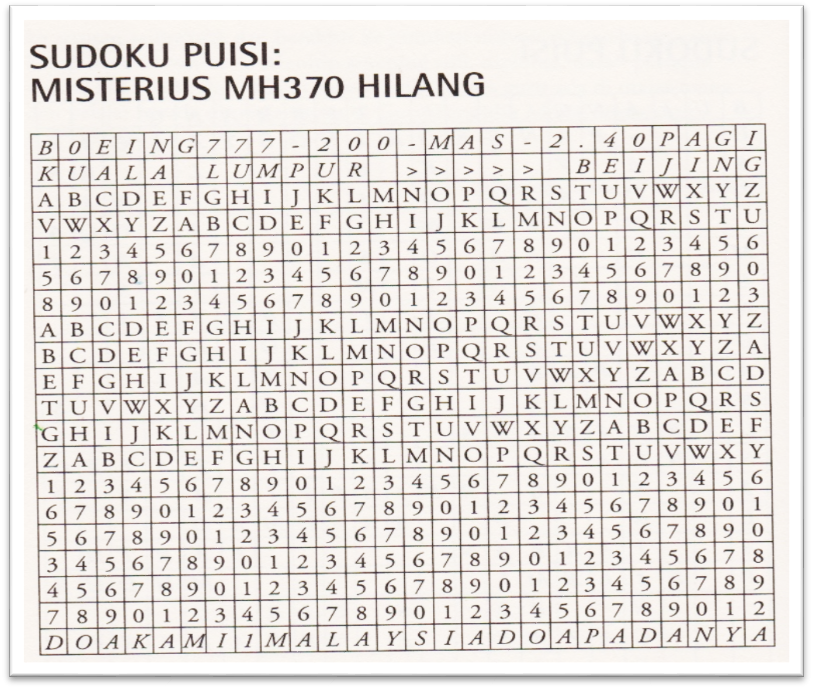
Form
The form of the poem “Sudoku Puisi: Misterius MH370 Hilang” in Figure
Themes and Questions in Poetry
This poem has the theme of the mysterious disappearance of the missing MH370 as it is based on the poem presented in the form of Sudoku. The poet has posted some answers to the questions posed to the audience based on the mysterious title of the missing plane, ‘Sudoku Puisi: Misterius MH370 Hilang’. Among these, surely readers will be able to find out what type of missing aircraft is the ‘MAS’ ‘BOEING ‘777’. The next question arises as to where? Why not? When? The result in the Sudoku poem which names the place 'KUALA LUMPUR', 'BEIJING', '2.40 PAGI' explains the question arising from this poem. Subsequent rendering of numbers and letters aloud creates a question mark effect on the reader. The interpretation of the study found that this poem shows the impasse of the public in search of a mysterious solution to the disappearance of MAS BOEING 777, which departed from Kuala Lumpur to Beijing at 2.40am. This has caused the whole world to grieve especially Malaysians. This grief is expressed in the final line of this poem, ' DOA KAMI 1 MALAYSIA DOA PADANYA’. It turns out that this verse expresses the hopes of the whole family and community in Malaysia regardless of race and religion in prayer to Allah the Creator to solve the mysterious issues of the day.
The Poet’s Thought
According to the analysis of the poem, the poet was so affected by the mysterious disappearance of MH370 on March 08, 2014 that he produced a poetic title depicting the mystery story of the missing plane. Poets may want to embed a puzzle and expect the audience to pay attention and make sense. The poet also shows the order of numbers and alphabets and distortions to represent the anxiety and sadness of the people. Likewise, the alphabetical order of words that mean the prayers and hopes of the whole world, especially the Malaysians who are so eager to pray and hope for the miracle of solving the mysterious disappearance of MH370. The display of numbers, letters, and plaques illustrates the mathematical concepts incorporated in the poem. On the other hand, issues related to MH370 have become a global issue. Thus, much help and assistance has been contributed to help locate and justify the loss of MH370 passengers and crew. The upheaval depicted in Sudoku-shaped parcels was also influenced by viral issues by the media of the day including on Facebook page where the issue was played out while the victim's family members needed attention and care.
An Analysis of The Poem ‘Sudoku Puisi: MAS MH17-7/17
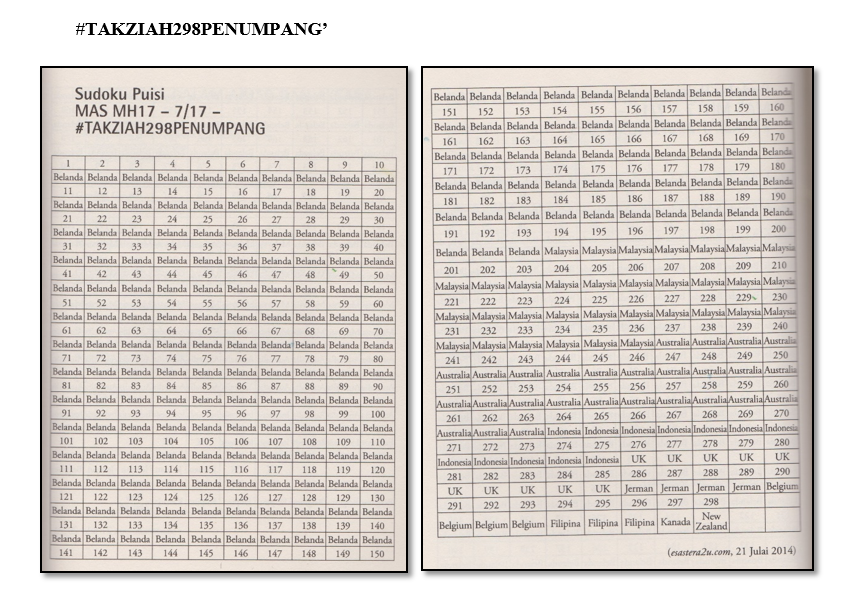
Form
'Sudoku Poetry: MAS MH17-7 / 17- # TAKZIAH298PENUMPANG' as shown in Figure
Finally, numbers 286 to 289 represent passengers from Germany. Whereas numbers 290 to 293 represent passengers from Belgium. Numbers 294 to 296 represent passengers who originated from the Philippines, while the number 297 represents passengers from Canada and the last, number 298 represents contributors from New Zealand. In conclusion, the forms used clearly show the poet is meticulous in arranging the numbers according to the number of victims of the tragedy. Readers will be able to conclude based on the poem the number of victims of tragedy. Among them were the victims of 193 Dutch, 33 Malaysians, 27 Australians, 12 Indonesians, 10 UK citizens, 4 Germans, 4 Belgians, 3 Filipinos and one Canadian and New Zealand. The total number of victims was 298 passengers. It turns out that the form of poetry that is revealed through the display of numbers makes the audience excited to unravel it and encourage critical thinking.
Themes and Questions in Poetry
According to the study, this poem carries a humanitarian theme that shows the number of passengers killed that was 298 people. The poet also shows the number of passengers in the affected countries, including the Netherlands, Malaysia, Australia, Indonesia, UK, Germany, Belgium, Philippines, Canada and New Zealand. The voice of humanity is carefully presented based on the tragedy most people around the world regret. The crash of the MH17 passenger plane crashed on July 17, 2014. All 283 passengers and 15 crew on board the Boeing 777 were killed in the tragedy. According to news sources, the plane was flying from Amsterdam to Ukraine near the Russian border. Various questions arise from the exposition of the total number of victims. Which is why the MH17 passenger plane was shot down? Who is responsible for the tragedy? What role do the international tribunals play in the investigation and prosecution of offenders? This tragedy is an international issue and involves the safety of the world community. If the passenger plane were to be shot down arbitrarily, the world would be in chaos. Thus, this poem echoes the voice of the world community who want this case to be investigated fairly. The poet also voiced the sadness of the community by displaying the words '# TAKZIAH298PENUMPANG' addressed to the entire family of the victims. The public is exposed to the tragedy issue to open the eyes of the community to sympathize with the families of the victims. Indeed, the support and contribution of the community will be able to relieve the hearts and feelings of the victims' families.
The Poet’s Thought
This study can shed light on the poet's deep concern for humanitarian issues. The voices featured in these sudoku-shaped poems are as profound and detailed as the human forms of poetry presented. The combination of form and content will make the poem more meaningful and engaging for the audience to experience it. The poet is very careful in producing his poems. Based on information from the poem, it is possible to know the poet first to study and investigate the news of this tragedy. Subsequently, based on detailed studies, the poet incorporates mathematical elements such as the number of victims of tragedy and the victims’ country of origin to better benefit and inform the reader. In conclusion, the poet presents humanitarian issues that invite people to think and live by them and provide support and contribution to victims of tragedy. The issue of universal humanity needs to be addressed by all groups of people in order to maintain peace and stability around the world.
Conclusion
Overall, based on the Sudoku-shaped poem produced by the poet Puzi Hadi, it was found that these poems feature some mathematical elements that include Sudoku game form and numbers. The combination of form and content to convey meaning makes this poem a very good quality and enhances the level of thinking of the audience to eat it. The three poems in this study feature mathematical elements that make the poem very interesting to read and appreciated by the poetry audience. Furthermore, based on the study, these sudoku-shaped poems are very interesting and they encourage critical thinking. Readers need to decipher this short poem by critically examining and reviewing it. These sudoku-shaped poems are different from ordinary poems that feature text only. Based on the poem, the reader will be curious and will seek answers to the questions with more specific research. It turns out that the sudoku-shaped poems are very interesting to introduce to the poetry lovers of the literature and will attract the poetry lovers from non-literary groups such as scientists and mathematicians.
The age of science and technology has made society think in every respective area. The production of sudoku-shaped poetry by Puzi Hadi is a pioneer in the development of modern poetry in Malaysia. Naturally, scholars need to be more aware of the development of poetry abroad to serve as a guide to further study the development of modern poetry in Malaysia. The production of sudoku poems reflects the thinking of a poet who wants a literary work that is able to attract readers from all walks of life.
The conceptualization of mathematical concepts in these sudoku-shaped poems clearly demonstrates the divergence of ordinary poems that are focused on text alone. The mathematical concepts are integrated into the forms of poetry producing sudoku-shaped poems. Current issues such as politics and humanity are raised in the production of this poem to educate the public on the need for sensitivity to global issues in order to maintain the stability and harmony in Malaysia. The spirit of patriotism will be fostered by the humanitarian issues highlighted by the author. In conclusion, these poems are a precursor to the production of better and more impactful sudoku-shaped poems in the future.
References
- Abdullah, A. K., & Yusof, A. R. H. (1990). Puisi Baharu Melayu 1961-1986 [New Malay Poetry 1961-1986]. Dewan Bahasa dan Pustaka.
- Abdullah, I. (2013). Berfikir Kritis Matematik [Think Critically Mathematically]. Jurnal Matematika Pendidikan Matematika, 2(1), 66-75. http://www.ejournal.unkhair.ac.id/index.php/deltapi/ article/view/100/69
- Akbar, A. (2015). Kebijakan Luar Negara Amerika Serikat Terhadap Mesir Pada Paruh Pertama Pemerintahan Muhammad Mursi [United States Foreign Policy Against Egypt in the First Half of Muhammad Mursi's Reign]. Skripsi Gelar Sarjana Sosial. Universitas Islam Negeri Syarif Hidayatullah, Jakarta. http://repository.uinjkt.ac.id/dspace/bitstream/123456789/28062/1/ALI %20AKBAR-FISIP.pdf
- Atmazaki, B. (1993). Analisis Sajak: Teori, Metodologi & Aplikasi [Poetry Analysis: Theory, Methodology & Application]. Angkasa.
- Aziz, S. A. (2003). Teori dan Kritikan Sastera [Literary Theory and Criticism]. Dewan Bahasa dan Pustaka.
- Hadi, P. (2012). Dot Dot Dot. Esastera Enterprise.
- Hadi, P. (2016). Sudoku Puisi. Institut Terjemahan & Buku Malaysia.
- Jussien, N. (2007). A to Z of Sudoku. ISTE Ltd.
- Lajeunesse, L. (2018) “Poetry Puzzle”. Bridges. Conference Proceedings, School Of STEM, Capilano University, North Vancouver, Canada. (pp. 645-648). https://archive.bridgesmathart.org/2018/ bridges2018-645.pdf
- Osman, A. (2013). Krisis Mesir: ‘Sepihan Hosni’ Bunuh Demokasi [Egyptian Crisis: ‘Sepos Hosni’ Kills Democracy]. Al-Ahkam.Net. http://www.al-ahkam.net/home/pandangan-dr-maszlee-malik-tentang-krisis-di-mesir
- Salleh, M. H. (1988). Pengalaman Puisi [Poetry Experience]. Dewan Bahasa dan Pustaka
- Sang, M. S. (1996). Penyuburan Matematik: Untuk Diploma Perguruan Malaysia [Fertilization of Mathematics: For the Malaysian Diploma in Teaching]. Kumpulan Budiman Sdn. Bhd.
- Scott, W. S. (1966). Five Approahes of Literary Criticism. The Macmillan Company.
- Sikana, M. (2013). Koleksi Teori Sastera [Literary Theory Collection]. Pustaka Karya.
Copyright information

This work is licensed under a Creative Commons Attribution-NonCommercial-NoDerivatives 4.0 International License.
About this article
Publication Date
12 October 2020
Article Doi
eBook ISBN
978-1-80296-088-4
Publisher
European Publisher
Volume
89
Print ISBN (optional)
-
Edition Number
1st Edition
Pages
1-796
Subjects
Business, innovation, sustainability, environment, green business, environmental issues, urban planning, municipal planning, disasters, social impact of disasters
Cite this article as:
Hashim, N., & Ain, R. (2020). The Conceptualization of Mathematics in Sudoku Poetry by Puzi Hadi. In N. Samat, J. Sulong, M. Pourya Asl, P. Keikhosrokiani, Y. Azam, & S. T. K. Leng (Eds.), Innovation and Transformation in Humanities for a Sustainable Tomorrow, vol 89. European Proceedings of Social and Behavioural Sciences (pp. 562-575). European Publisher. https://doi.org/10.15405/epsbs.2020.10.02.51

